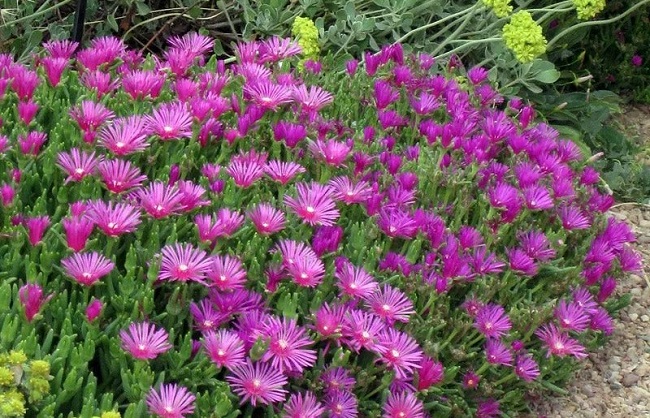The ice plant (Delosperma spp.) is a remarkable and visually captivating ground cover that thrives in arid and sunny environments. Known for its unique appearance and ability to withstand harsh conditions, the ice plant is a popular choice for water-wise landscaping and adding vibrant colors to gardens. If you’re looking to cultivate this resilient and beautiful plant, this comprehensive guide will walk you through the steps of growing the ice plant successfully.

Understanding the Ice Plant
The ice plant gets its name from the glistening appearance of its succulent leaves, which resemble dew-covered ice crystals. Native to South Africa, this plant belongs to the Aizoaceae family and has evolved to thrive in arid and coastal regions, making it an ideal choice for xeriscaping and drought-tolerant gardens.
Choosing the Right Variety
There are several species and cultivars of ice plants, each with unique color variations and growth habits. Some popular varieties include Delosperma cooperi (purple ice plant), Delosperma nubigenum (yellow ice plant), and Delosperma ‘Fire Spinner’ (orange and red hues). Choose a variety that suits your color preferences and growing conditions.
Planting and Growing
1. Location
The key to successfully growing ice plants is providing them with plenty of sunlight. These plants thrive in full sun to light shade, so choose a location with at least 6 hours of direct sunlight per day.
2. Soil Preparation
Ice plants prefer well-draining soil. If your soil is heavy or clay-like, consider amending it with sand, gravel, or other materials to improve drainage.
3. Planting Time
Plant ice seeds or young seedlings in the spring or fall when temperatures are mild. Avoid planting during extreme heat or cold.
4. Spacing
When planting ice plants, space them around 12 to 18 inches apart to allow room for their spreading growth habit.
5. Watering
While ice plants are drought-tolerant, they do require regular watering during their establishment period. Once established, water them sparingly, allowing the soil to dry out between waterings.
6. Mulching
Applying a layer of mulch around the plants can help retain soil moisture and suppress weeds. However, avoid placing mulch directly against the plant stems.
7. Fertilization
Ice plants generally don’t require heavy fertilization. A light application of a balanced, slow-release fertilizer in the spring can provide the necessary nutrients.
Care and Maintenance
1. Pruning
Ice plants benefit from occasional pruning to remove dead or faded flowers. This encourages new growth and prolongs the blooming period.
2. Winter Care
In colder climates, ice plants may need some protection during the winter months. Consider covering them with a light layer of straw or using frost cloth if frost or freezing temperatures are expected.
3. Propagation
Ice plants can be propagated through seeds or cuttings. Collect seeds from the plant after flowering and sow them in well-draining soil. Cuttings can be taken from healthy stems and rooted in a suitable medium.
Conclusion
The ice plant is a striking and resilient ground cover that offers both visual appeal and water-saving benefits. By following these planting and care guidelines, you can successfully cultivate ice plants and create a vibrant and drought-tolerant landscape. Whether you’re adorning garden beds, rock gardens, or containers, the ice plant’s dazzling display of colors and easy maintenance make it a valuable addition to any gardening endeavor.
12 Fun Facts About the Ice Plant
Glistening Appearance
The ice plant gets its name from the sparkling appearance of its succulent leaves, which resemble tiny ice crystals or dewdrops, especially when caught in the sunlight.
Succulent Wonder
Ice plants belong to the succulent family, known for their ability to store water in their leaves, stems, or roots. This adaptation helps them survive in arid and dry environments.
Coastal Adaptation
Many ice plant species are native to coastal regions, where they play a significant role in stabilizing sand dunes and preventing erosion due to their ability to thrive in sandy and windy conditions.
Edible Potential
Some species of ice plants are edible and have a slightly salty and tangy flavor. They are sometimes used as garnishes or added to salads for a unique touch.
Drought Tolerance
Ice plants are renowned for their exceptional drought tolerance. Their succulent nature allows them to withstand prolonged periods of drought with minimal water.
Invasive Concerns
While some ice plant varieties are cultivated for landscaping purposes, certain non-native species have become invasive in certain regions, outcompeting native plant species. It’s important to choose non-invasive varieties for your garden.
Color Variations
Ice plants come in an array of vibrant colors, including shades of pink, purple, orange, red, and yellow. These colorful blooms make them popular choices for adding a splash of color to landscapes.
Pollinator Attraction
The bright and showy flowers of ice plants are magnets for pollinators such as bees, butterflies, and even hummingbirds. They play a role in supporting local ecosystems and promoting biodiversity.
Rock Garden Gems
Ice plants are often used as ground covers in rock gardens due to their ability to thrive in well-draining, rocky soils and their striking appearance against the backdrop of stones.
Diverse Origins
Ice plants belong to the Aizoaceae family, which includes a wide range of succulent species. They can be found in various parts of the world, including South Africa, North America, and Australia.
Salt Tolerance
Many ice plant species are salt-tolerant, making them suitable for coastal gardens where soil may have elevated levels of salt content.
Xeriscaping Heroes
Due to their drought tolerance and low water requirements, ice plants are considered excellent choices for xeriscaping, a landscaping approach that focuses on water conservation.
Related Articles & Free Email Newsletter Sign Up
4 Low Maintenance Shrubs for a Beautiful and Hassle-Free Landscape
How to Grow Canadian Hemlock for Landscapes




Comment here